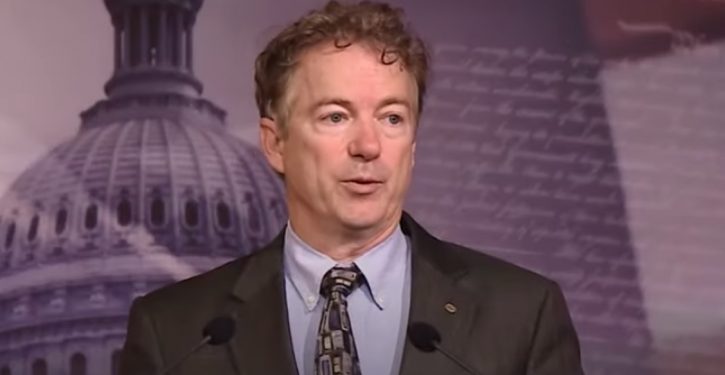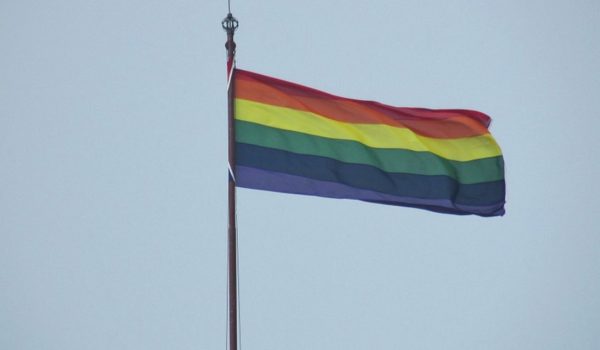
Most are probably aware that Senator Rand Paul (R-KY) has tried twice to have a question for the House impeachment managers read to the Senate by Chief Justice John Roberts. He submitted the question on Wednesday, and again on Thursday. Roberts declined to read the question both times.
It’s humorous enough that Roberts’s refusal to read the question confirms and highlights that a former official of the National Security Council is the so-called “whistleblower,” who submitted the lawyers’ brief in August 2019 about President Trump’s 25 July phone call with President Zelensky of Ukraine.
Senator Paul said nothing that would have led to that conclusion. He asked a legitimate question about two former NSC officials, one of whom is now working for Rep. Adam Schiff on the staff of the House Intelligence Committee. He didn’t say the word “whistleblower” or allude to the “whistleblower” in any way.
Will this presidential election be the most important in American history?
But Roberts reacted by refusing to read the question, and the news media and the Democrats have reacted as if Paul was trying to out the “whistleblower.”
LOL, as they say. (It wouldn’t be the first time the media or the Democrats have themselves outed the “whistleblower.”)
Paul’s question was a good one, however. He read it to the media on Thursday:
.@RandPaul reads the question Chief Roberts wouldn't let him ask.pic.twitter.com/3YO0RtQnHC
— BlazeTV (@BlazeTV) January 30, 2020
And tweeted it out (whereupon Trump retweeted it).
My exact question was:
Are you aware that House intelligence committee staffer Shawn Misko had a close relationship with Eric Ciaramella while at the National Security Council together 1/2
— Senator Rand Paul (@RandPaul) January 30, 2020
Paul’s question is highly relevant to the proceedings, first of all because of the former NSC official, Sean Misko, who is now working for Adam Schiff. Among other things, Misko reportedly was overheard on a number of occasions in 2017 talking to fellow staffer Eric Ciaramella, with whom he is said to have a close working relationship, about ways to force President Trump out of office.
This information isn’t just vague hearsay reported in conservative media. It is linked to information that circulated among lawmakers on Capitol Hill last fall. The names of both Misko and Ciaramella came up immediately when the origins of the “whistleblower’s” lawyers’ brief from August 2019 began to emerge. A “dossier” documenting some of their previous activities was provided to Congress by witnesses (see below).
Ciaramella, moreover, held his NSC job as a staffer for then-Vice President Joe Biden, in the Executive Office of the Vice President (EOVP), and his work was focused on Biden’s activities in Ukraine. Rand Paul made the point back in November 2019 that for that reason alone, Ciaramella needed to be called for testimony.
Legislators were also familiar with the name Eric Ciaramella from the Mueller Report.
Hold aside, for a moment, the store of information about Misko’s and Ciaramella’s connections and their relevance to the August 2019 brief about the Ukraine phone call. There’s an equally interesting sequence of events from May 2017 documented in the Mueller Report, and involving at a minimum Eric Ciaramella.
A previous attempt to manufacture a case against Trump?
The incident in question centered on the leak about Trump allegedly giving away intelligence secrets to the Russians in a meeting with Foreign Minister Sergei Lavrov. This meeting occurred on 10 May 2017, the day after Trump fired James Comey as FBI director. Eric Ciaramella sent an email on 10 May about the meeting with Lavrov, which is the one cited in the Mueller Report (see p. 71, footnote 468).
The Mueller Report doesn’t indicate who the recipients of the email were, other than “Kelly,” who presumably was retired Marine Corps General John Kelly, at that time the Secretary of Homeland Security.
Note: I find that remarkable – that Ciaramella, a subordinate official at the NSC, sent an email directly to the DHS secretary. The citation’s format indicates that Kelly was the direct and primary recipient. That alone should get the radar going, not only because of the irregular communication path, but because of what it might say about the situation and the sender’s tactics. (That’s a specific point, not a general one. The email apparently copied additional recipients and was meant to be seen. The DHS secretary was probably not the most relevant official to send it to, if the concern was about a foreign-influence suspicion regarding the president and the Russians. Reasons why Ciaramella would have sent it to Kelly need accounting for; e.g., what Kelly’s “internal politics” stance as a senior cabinet official was at the time, what Ciaramella – and possibly others at the NSC – hoped to achieve by sending it to Kelly; etc.)
Paul Sperry, in his article about Ciaramella in October 2019, alluded to a similar point:
In May 2017, Ciaramella went “outside his chain of command,” according to a former NSC co-worker, to send an email alerting another agency that Trump happened to hold a meeting with Russian diplomats in the Oval Office the day after firing Comey, who led the Trump-Russia investigation. The email also noted that Russian President Vladimir Putin had phoned the president a week earlier.
Lee Smith, author of The Plot Against the President, spoke to Laura Ingraham this week, describing the import of the email (video below):
What this email is – it appears in the Mueller Report. It’s cited in the Mueller Report. The Mueller Report uses this email to insinuate that Donald Trump fired James Comey at the behest of the Russians. Shortly after the date of this email, then-Acting Director Andrew McCabe opens up an investigation of Donald Trump, wondering if he [Trump] is acting at the behest of the Russians.
What this looks like is, that the person known as the whistleblower appears to have a habit of trying to set up the President in different intelligence operations; first, with the counterintelligence investigation in 2017 [i.e., the one initiated by McCabe as described above. – J.E.], and now, with impeachment.
The Mueller Report, as can be seen at the link above, implied that James Comey’s firing (which was done on 9 May) was connected to the planning for the 10 May meeting with Lavrov. In October 2019, the Washington Examiner had this summary:
The Mueller report footnote referenced Ciaramella’s emails when it stated that “the meeting had been planned on May 2, 2017, during a telephone call between the President and Russian President Vladimir Putin, and the meeting date was confirmed on May 5, 2017, the same day the President dictated ideas for the Comey termination letter to [Trump aide] Stephen Miller.”
The body of the Mueller report went on to quote from a New York Times article published on May 19, 2017, that cited an “American official” who read a “document summarizing the meeting” to the reporters.
The Ciaramella email, with its prominence in the Mueller Report, looks like Candidate One for the “document summarizing the meeting” that was read to the New York Times reporters.
In the discussion with Lee Smith and Sara Carter, Laura Ingraham also cued up a video clip of Andrew McCabe making the case insinuated in the Mueller Report – based on Comey’s firing and the contemporaneous meeting with Lavrov, planned with Putin a week before – that Trump had an inappropriate relationship with the Russians.
Background on the NSC staffers’ activities already known to Congress
Read the Sperry article for more on concerns about Ciaramella, including those expressed by his colleagues at the NSC. The next passages from Sperry’s 2019 report discuss the information mentioned above that was circulating on Capitol Hill (emphasis added):
In effect, Ciaramella helped generate the “Putin fired Comey” narrative, according to the research dossier making the rounds in Congress, a copy of which was obtained by RealClearInvestigations.
Ciaramella allegedly argued that “President Putin suggested that President Trump fire Comey,” the report said. “In the days after Comey’s firing, this presidential action was used to further political and media calls for the standup [sic] of the special counsel to investigate ‘Russia collusion.’ “
The “research dossier” appears to be separate from the findings of the Mueller Report, and to corroborate the inference teed up by Lee Smith that the Mueller Report reflects a narrative planted by Ciaramella’s email.
Sperry continues (again, this is from October 2019): “With Ciaramella’s name long under wraps, interest in the intelligence analyst is so high that a handful of former colleagues have compiled a roughly 40-page research dossier on him. A classified version of the document is circulating on Capitol Hill, and briefings have been conducted based on it.”
Any such research dossier would include interactions with Sean Misko, given the reporting that he and Ciaramella frequently discussed ways of getting the president removed from office.
It’s no wonder members of Congress would want to question Ciaramella and Misko. Failing that, Senator Paul’s question about them to the House Democrats’ impeachment team is right on target, given the nature of the impeachment proceeding: Misko obviously involved in it, as a House Intelligence staffer, and Ciaramella having worked the Ukraine portfolio at the NSC, in particular as an aide to Joe Biden.
The Italian connection, again
But there’s a little bit more to consider as well. There’s an eye-catching coincidence from the timeframe of those brief days in May 2017. We can agree to view it as a total coincidence for the purposes of this article, and readers can decide if they think it’s more than that.
Last year, I reported on developments in Italy – and involving Italians – that related to the Spygate drama. The immediate cue for that article was an abrupt series of resignations from the senior ranks of Italian national intelligence, which oddly enough occurred not long after the Mueller Report was published, and immediately after Attorney General William Barr disclosed that John Durham had —already – been quietly investigating Spygate for the last two months.
The culminating point of the article was that very senior Italians, including former Prime Minister Matteo Renzi and a former diplomat and intelligence official, Giampiero Massolo, who is connected to Link Campus University, met at a private dinner with former President Barack Obama in Milan on 8 May 2017. Obama was in Milan to keynote a conference on sustainable agriculture.
Eric Ciaramella, of course, attended the luncheon for Matteo Renzi hosted by Joe Biden in October 2016, when Renzi made the last state visit of the Obama presidency.
Paul Sperry noted this about that: “Several U.S. officials told RealClearInvestigations that the invitation that was extended to Ciaramella, a relatively low-level GS-13 federal employee, was unusual and signaled he was politically connected inside the Obama White House.”
Again, let us assume it is merely coincidence that then-PM Renzi came for a state visit in October 2016; Ciaramella – a GS-13 staffer focused on Ukraine and Russia – was invited to his boss’s luncheon for the Italian PM* during that visit; and on 8 May 2017, Renzi was closeted with Obama, the day before Comey was fired on 9 May 2017, which was the day before Trump met with Lavrov on 10 May 2017 and Ciaramella sent an email to the Secretary of Homeland Security, which email was later interpreted by Robert Mueller’s team as suggesting that Trump made his plan to fire Comey in collusion with the Russians, sometime between 2 and 5 May 2017.
That is probably all coincidence. (It’s probably coincidence that, according to evidence lodged with an Italian court, Italian intelligence operatives visited the U.S.-located servers of entrepreneur Giulio Occhionero between 9 and 12 May 2017 and attempted to plant copies of Hillary Clinton’s emails on them. At this last link, please find a timeline with additional coincidences in the timing of Barr and Durham’s pursuit of Spygate’s background in Italy, in the late summer and fall of 2019, and the developing impeachment campaign kicked off in August and pursued vigorously by the Democrats in the House.)
We’ll assume that it is all coincidence. As Rand Paul suggests, however, there are a lot of questions that need to be answered. The first one would be how in the world any of this points to a need to impeach Donald Trump.
* As I have noted before, Ciaramella is an Italian name. If Ciaramella speaks Italian, however, that has not been previously listed among his accomplishments.




